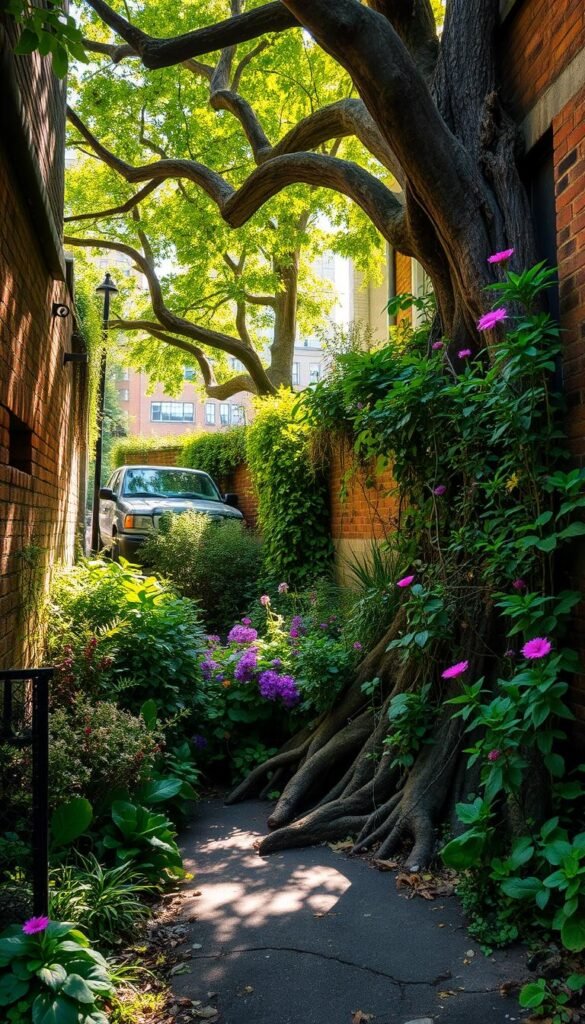What if your tiny balcony or fire escape could burst with color and life without strict rules? Meet chaos gardening—a liberating way to grow plants by letting nature take the lead. Instead of rigid rows, you scatter seeds and watch unexpected beauty unfold.
This approach flips traditional gardening on its head. No blueprints. No pressure. Just toss hardy seeds like wildflowers or herbs into containers or patches of soil. Over time, your space becomes a lively mix of textures and hues that pollinators love.
Urban expert Kori Kasper calls it “organized serendipity.” Even concrete jungles can host thriving green havens when you embrace a little chaos. The best part? It’s nearly impossible to fail—nature handles most of the work.
Ready to transform your cramped corner into a buzzing sanctuary? Below, you’ll find simple steps to start your wild garden, plus clever hacks for maximizing small areas. Let’s redefine what a “perfect” outdoor space looks like—one happy accident at a time.
Introducing the World of Chaos Gardening
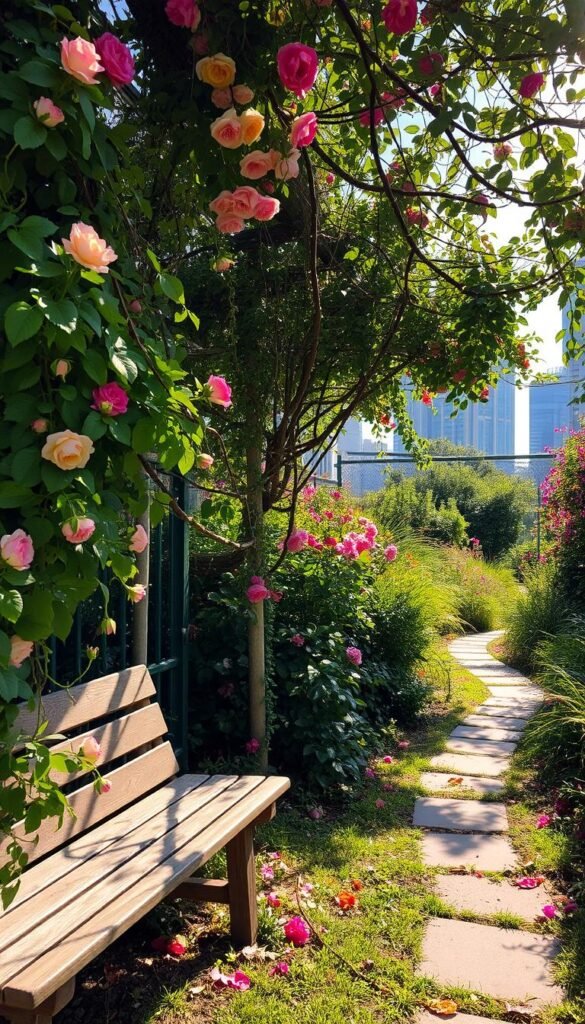
Picture a garden where unpredictability is the blueprint and every sprout tells its own story. This method tosses out rulers and grids, inviting nature to design your green oasis. Forget perfectly spaced rows—here, plants mingle freely, creating a living tapestry of textures and hues.
Understanding the Basics
Start by scattering a mix of seeds—wildflowers, herbs, or leafy greens—across your soil. No measuring needed. Just refresh the dirt with compost, sprinkle your chosen varieties, and let rain or watering do the rest. Over weeks, you’ll see surprises: maybe poppies tower over thyme, or kale shares a pot with marigolds.
Choose seeds suited to your local climate. Sun-loving varieties thrive in south-facing spots, while shade-tolerant options work under eaves. The goal? Mimic how nature spreads plants in meadows—random, resilient, and riotously beautiful.
What Makes Chaos Gardening Unique
Traditional gardens demand precision. Chaos gardens celebrate happy accidents. See how they compare:
| Traditional Gardening | Chaos Gardening | |
|---|---|---|
| Planning | Blueprints required | No plans needed |
| Seed Placement | Exact spacing | Free-form scattering |
| Maintenance | Frequent weeding | Selective pruning |
Even weeds play a role—some attract pollinators or add visual grit. Pull only what truly bothers you. Your space evolves through seasons, with hardier flowers reseeding themselves. It’s gardening that breathes, adapts, and never looks the same twice.
Why Chaos Gardening Works in Urban Spaces

Imagine turning your cramped patio into a living mosaic where plants dance freely. This approach thrives in tight spots because it works with space constraints rather than against them. A single container can host a kaleidoscope of blooms and greens when you let nature arrange them.
Small Footprint, Big Impact
Start with a diverse seed mix—sunflowers, basil, and creeping thyme all play nice. Scatter them in window boxes or repurposed crates. Over time, you’ll see unexpected partnerships form. Tall stems provide shade for low-growing herbs, while vibrant flowers attract city pollinators.
Here’s why this way beats traditional methods for concrete jungles:
| Urban Challenge | Wild Garden Solution |
|---|---|
| Limited square footage | Vertical growth & mixed plantings |
| Unpredictable sunlight | Self-selecting plants adapt naturally |
| Time constraints | Minimal weeding needed |
City Life Meets Untamed Beauty
Forget daily watering marathons. These gardens need hydration only during dry spells. The layered plant mix creates natural mulch, locking in moisture. You’re left with more time to enjoy your green retreat than maintain it.
Even postage-stamp balconies become dynamic ecosystems. Birds visit sunflower heads. Bees buzz between oregano blooms. This approach proves that beauty doesn’t require control—just a willingness to let life unfold.
Getting Started with Chaos Gardening
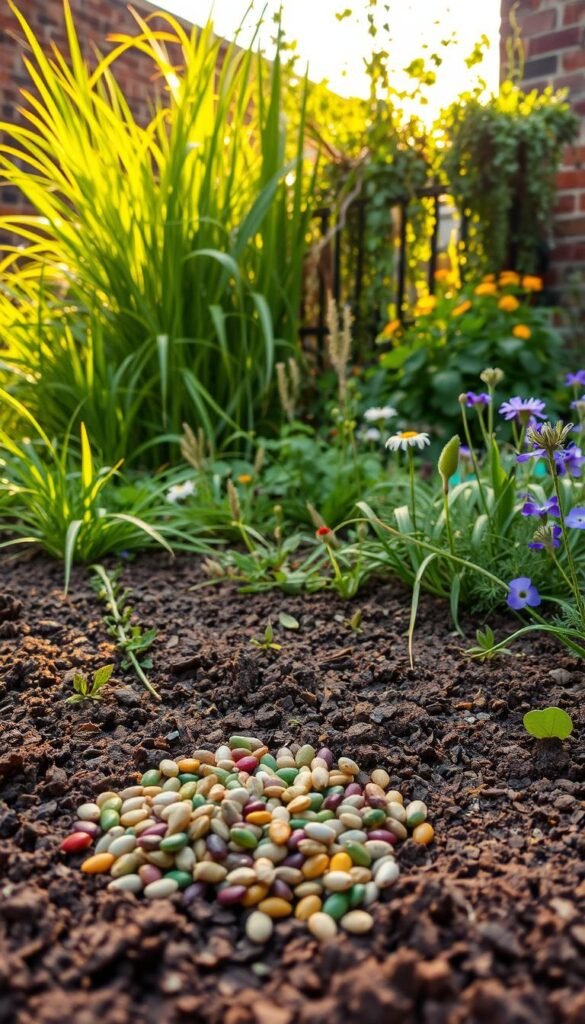
Who says you need a green thumb to create a vibrant urban oasis? This method thrives on simplicity. Just grab seeds, clear a spot, and let nature handle the rest. Here’s how to begin your wild journey.
Selecting the Right Seeds for Your Climate
Start with native wildflowers and herbs that match your local weather. Sun-loving varieties like coneflowers work in bright spaces, while shade-tolerant ferns suit dim corners. Mix in plants that attract beneficial insects—like milkweed for monarchs or dill for swallowtails.
Experts recommend blends with at least five flower types for visual variety. Avoid fussy hybrids—stick to hardy annuals and perennials. Check seed packets for phrases like “self-sowing” or “drought-tolerant” to ensure low maintenance.
Preparing Your Urban Garden Space
Clear existing weeds from containers, raised beds, or ground plots. Loosen compacted soil with a fork, then mix in compost. Unlike traditional gardening, you won’t need precise rows—just mark boundaries with stones or edging to keep your wild flower display contained.
Now the fun part: scatter seeds like you’re feeding chickens. Cover lightly with soil (or just step on them). Water gently for the first two weeks. Then step back—plants grow best when left to their own devices.
Remember: the only rules are to enjoy the surprises and resist over-tidying. Your second planting season will be even easier as resilient varieties reseed themselves.
Key Tips for a Successful Chaos Garden
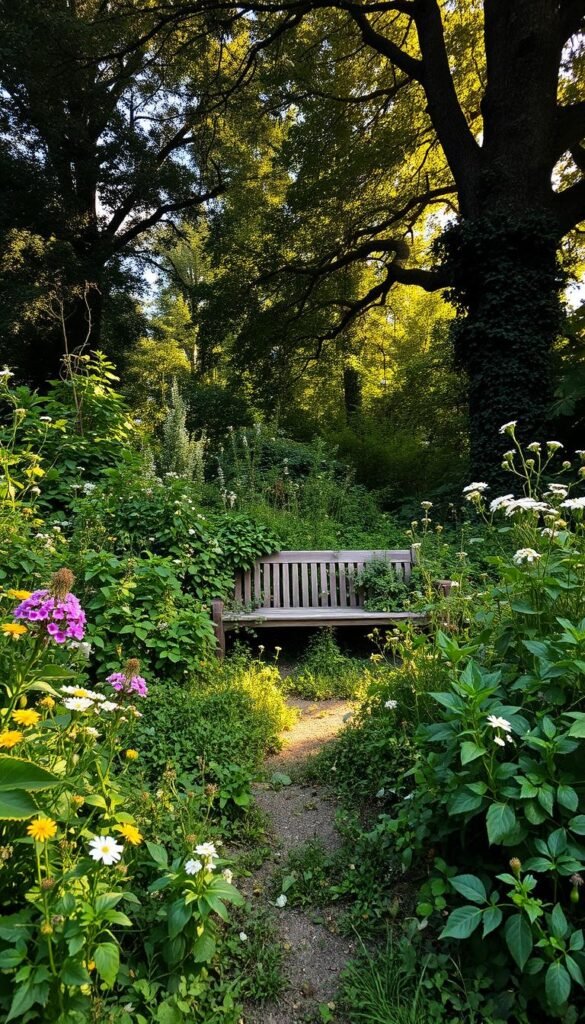
Your wild green space becomes most vibrant when you balance care with calculated neglect. Focus on these essentials to nurture beauty while preserving your garden’s free-spirited charm.
Water Wisdom: Less Precision, More Observation
Chaos gardens need hydration that mimics natural rainfall. Stick your finger 1-2 inches into soil—water only if it feels dry. Morning watering reduces evaporation and helps insects access moisture all day.
Avoid rigid schedules. Containers might need watering every 3 days, while ground plots thrive with weekly soakings. Layer mulch from fallen leaves to retain moisture and feed your ecosystem.
Weeding With Purpose
Pull only plants that:
- Choke nearby growth (like bindweed)
- Host harmful pests
- Trigger allergies
Many “weeds” boost biodiversity. Clover nourishes soil, while dandelions feed early-spring bees. Let these helpers stay—they’re free landscape artists.
Seasonal shifts demand flexibility. In rainy periods, skip watering. During droughts, prioritize young plants. Trust that your garden’s beauty emerges through adaptation, not control.
By supporting this self-regulating ecosystem, gardeners create habitats where insects patrol for pests naturally. You’ll spend less time working and more time marveling at nature’s unruly masterpiece.
Design and Layout Ideas for Your Urban Chaos Garden
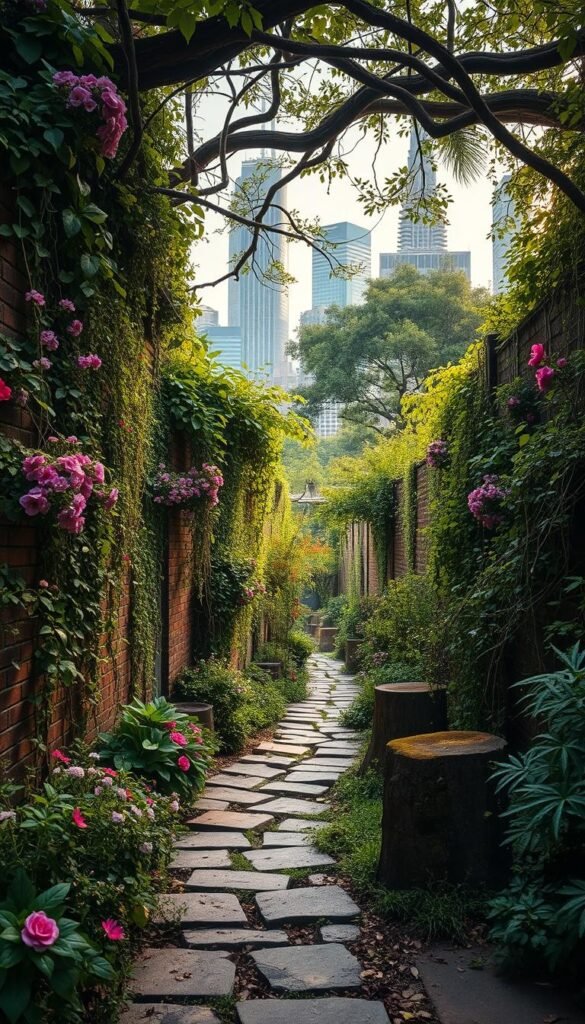
Ever wondered how a concrete corner could bloom into a living collage? By blending strategic design with nature’s randomness, you craft spaces where birds flock and herbs mingle with wildflowers. The secret lies in balancing spontaneity with subtle structure.
Incorporating Native Plants
Start with species that naturally thrive in your area. Milkweed supports monarch butterflies, while purple coneflowers attract beneficial pollinators. Local ecologist Dr. Lena Torres notes:
“Native plants create habitats while needing 60% less water than exotic varieties.”
Cluster sun-loving varieties near windows and shade-tolerant ferns under eaves for year-round texture.
Balancing Wild Elements and Structure
Define edges with low stone walls or repurposed bricks—they contain growth without stifling it. Let climbing vegetables like beans scramble up railings, while rosemary bushes form fragrant borders. This approach marries wildness with purpose, offering visual anchors amid the free-form benefits of nature’s chaos.
Utilizing Hardscaping for Definition
Add gravel paths between planting zones to navigate your space without trampling sprouts. Use reclaimed wood pallets as vertical planters for strawberries or thyme. These features guide the eye and feet, ensuring your garden feels intentional yet untamed. Rotate herbs and vegetables each season—swap winter kale for summer basil to keep the layout dynamic.
As birds return yearly to your evolving sanctuary, you’ll see how strategic touches amplify nature’s artistry. Let hardscapes frame the wildness, and watch every season rewrite your garden’s story.
Chaos Gardening for Urban Dwellers: Embracing a Wild Aesthetic
Think of your garden as a living storybook—each season writes a new chapter. While chaos gardens thrive on spontaneity, a dash of planning helps shape their wild charm. The goal? Guide growth without stifling nature’s creativity.
Start by mixing seed varieties that bloom at different times. This ensures bursts of color from spring through frost. Sunflowers might dominate one summer, while poppies steal the spotlight the next. Over years, your space becomes a dynamic tapestry only nature could design.
| Planned Element | Wild Result |
|---|---|
| Curated seed blend | Surprise color combinations |
| Strategic watering zones | Self-sufficient plant clusters |
| Seasonal soil refresh | Volunteer sprouts each spring |
You’ll notice others pausing to admire your ever-changing oasis. What seems haphazard to you becomes art to passersby—a testament to nature’s take on beauty.
The benefits chaos gardens offer go beyond aesthetics. Less time pruning means more moments sipping coffee amid buzzing bees. Let wind and wildlife handle seed distribution—next year’s layout will delight you anew.
Remember: every “mistake” adds character. A tomato plant sprouting in your flower pot? A happy accident. With each passing year, your garden grows wiser—and so do you.
Maintenance and Adaptability in Your Wild Garden
Your untamed green space grows wiser with each passing season—here’s how to work with nature’s rhythms rather than against them. While wild gardens demand less fuss, smart tweaks keep them thriving year after year.
Adjusting to Seasonal Changes
Spring calls for lighter watering as rains return. Let early blooms like violets and dandelions nourish emerging pollinators. Come summer, water deeply but less often—mature plants develop drought-resistant roots.
Autumn is prime reseeding time. Shake dried flower heads over soil to prep for next year’s surprises. Winter? Leave seed pods and stalks standing—they’re bird buffets and frost shields.
| Season | Key Task |
|---|---|
| Spring | Clear debris, spot-water seedlings |
| Summer | Mulch to retain moisture |
| Fall | Collect seeds, leave habitat |
Encouraging Beneficial Insects and Biodiversity
Plant clusters of purple coneflower and goldenrod—pollinators adore these late-summer buffets. Avoid pesticides; let ladybugs handle aphids. A shallow dish with stones makes perfect bee hydration station.
Keep these allies thriving:
- Leave leaf litter for butterfly larvae
- Grow mint or fennel near veggies
- Let clover fill bare patches
Every year, your garden becomes richer as native species establish themselves. Watch how chickadees follow wasps to caterpillar feasts—nature’s pest control at work. By embracing these cycles, you create a self-sustaining ecosystem that dazzles through all seasons.
Overcoming Challenges in a City Chaos Garden
Ever hit a snag while cultivating your wild urban oasis? Even carefree gardens face hurdles—but solutions exist that honor your space’s untamed spirit.
Navigating Municipal Regulations
Before scattering seeds, check local rules. Some cities limit plant heights on balconies or ban certain species. Urban gardener Marisol Reyes suggests:
“Attend a community board meeting or connect with urban gardening communities—they’ll know the loopholes.”
Use movable containers to comply with fire codes. Opt for compact native flowers if vertical growth gets flagged.
Dealing with Unwanted Weeds and Pests
Spot invasive plants early. Pull bindweed roots before they strangle your flowers. For aphids, introduce ladybugs instead of sprays—they’re nature’s cleanup crew.
| Issue | Wild-Friendly Fix | Benefit |
|---|---|---|
| Aggressive weeds | Hand-pull + mulch bare spots | Protects soil balance |
| Rodent visits | Plant mint borders | Natural deterrent |
| Fungal issues | Space plants for airflow | Reduces moisture |
If setbacks occur, refresh your seed mix each spring. Add clover to outcompete invaders while feeding beneficial insects. Remember—every challenge teaches your garden to adapt better next year.
Urban horticulturist Dev Patel notes: “Your wild space isn’t failing—it’s learning.” Embrace the messy middle. Soon, your resilient plants will handle city life like seasoned pros.
Celebrating Your Urban Wild Garden Journey
Your journey from scattered seeds to thriving green chaos redefines what urban growth can be. Each plant that sprouts tells a story—a marigold surviving sidewalk heat, mint cascading over a repurposed bucket. These aren’t just gardens; they’re living diaries of resilience.
Reflect on how your space evolves yearly. That basil patch overtaken by nasturtiums? A lesson in nature’s resourcefulness. Urban ecologist Dr. Mei Lin observes:
“Wild-style plots teach us flexibility—every ‘mistake’ strengthens the ecosystem.”
Celebrate small wins: a bee sipping from your cosmos, or kale surviving its first frost. Share photos with local gardening groups to inspire others. Your balcony’s untamed beauty might spark a neighbor’s green revolution.
This approach isn’t about perfection—it’s about partnership. As seasons shift, so does your role: less director, more delighted observer. Let wind carry next year’s surprises. Your garden knows what to do.

